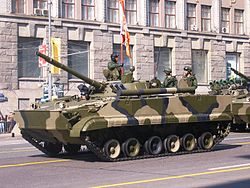LTT-03
| LTT-03 "Spartan" | |
|---|---|
 | |
| Type | Infantry Fighting Vehicle |
| Place of origin | Huvakia |
| Service history | |
| In service | 1987 - Present |
| Used by | Huvakian Armed Forces |
| Production history | |
| Designer | Arstrae Industrial Engineering |
| Designed | 1984 |
| Manufacturer | Arstrae Industrial Engineering Rottimotors Company |
| Produced | 1990 |
| No. built | 2,000+ |
| Specifications | |
| Weight | 18.7 Tonnes |
| Length | 7.14 m (23 ft 5 in) |
| Width | 3.2 m (10 ft 6 in) |
| Height | 2.4 m (7 ft 10 in) |
| Crew | 3 (commander, gunner, driver) |
| Passengers | 9 |
| Armor | Aluminum alloy Steel 35mm |
Main armament | 1 x 100 mm gun/launcher 1 x 30 mm autocanon HMG-3 Machine gun |
Secondary armament | 2 x Crew operated HMG-3 Machine Guns |
| Engine | Rotti UTD-29m Diesel 500 Hp |
Operational range | 600 km (370 mi) |
| Speed | 72 km/h (45 mph) on road 45 km/h (28 mph) off-road 10 km/h (6.2 mph) amphibious |
The Light Tank Transport is one of the most heavily armed infantry combat vehicles in service in any nation. The turret of the LTT-03 contains a low velocity, stabilized 100 mm rifled gun, which can fire conventional shells or ATGMs. 40 rounds are carried for the 100 mm as well as 8 compatible ATGMS. In addition to the 100 mm gun there is also a coaxial mounted 30mm autocannon right of the main gun as well as a coaxial mounted 7.62 mm machine gun left of the main gun. All of the main weapons of the vehilce can be fired with equal efficiancy from a halted, mobile, or amphibious position. An autoloader stores 22 rounds for the main weapon in a quick access magazine. The LTT continues to see updates as modern tactical equipment is introduced, such as infrared sights, and guidance systems. The rear section of the vehilce intended for troop transportation contains multiple firing ports enable the transported soldiers to fire out of the vehilce without exposing themselves.
Mobility
The vehicle has an unconventional layout. The engine is in the back of the vehicle to the right (unlike most other IFVs, which have the engine located forward in the hull). As a result, the driver is seated forward in the hull (in the center) together with two infantrymen (one on each side of the driver). The vehicle has a double bottom and the engine is located under the floor of the vehicle (troops enter/leave the vehicle over the engine). The remaining five infantrymen are seated aft of the two-man turret.